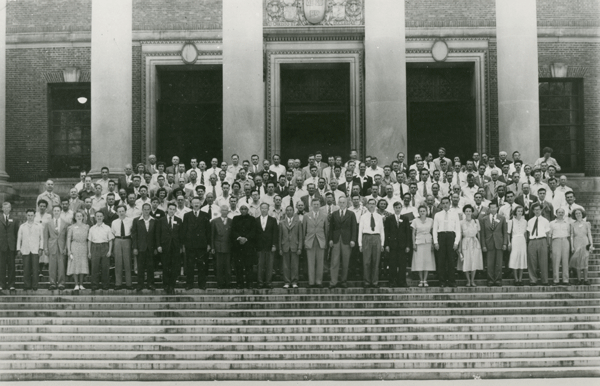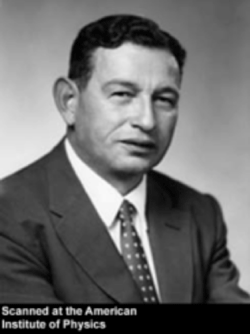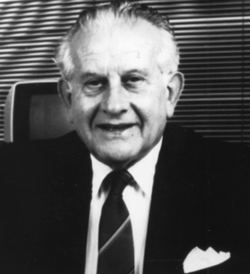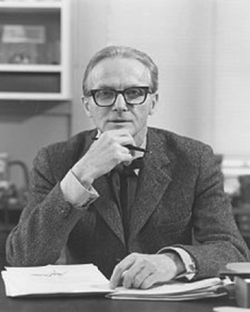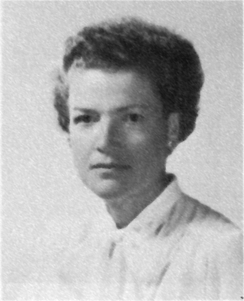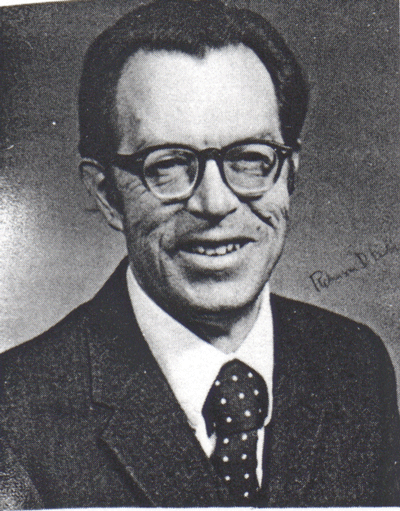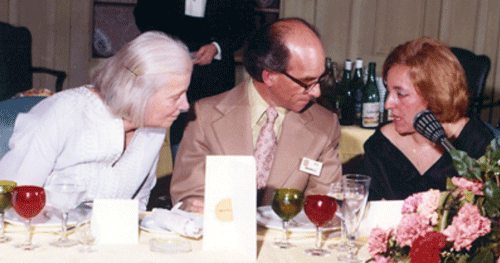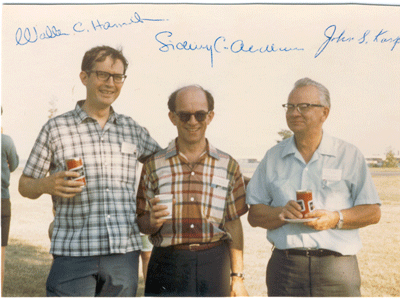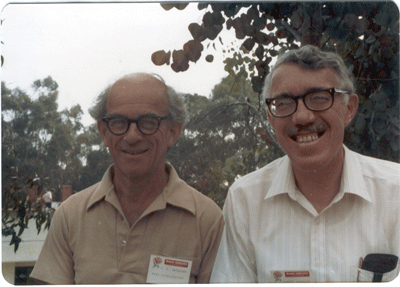- History Home
- People, Leadership & Service
- A Legacy of Excellence
- History & Impact
- Meetings Through the Years
- Resources
Memoir - Sidney C. Abrahams (1924 - 2021)Memoir | Publications | Curriculum Vitae | Videos | Slides | Articles | Obituary
Crystallographic Career of Sidney Cyril Abrahams Contribution to ACA History Project Born May 28, 1924 in London, England and educated at Ilford County High School 1935-1938 and Greenock Academy 1938-1942, the present writer graduated BSc with first class honors in chemistry in 1946 from the University of Glasgow where J. Monteath Robertson (JM) was Gardiner Professor of Chemistry. He had, by then, completed the infantry training required for commissioning as an Army second lieutenant in the event he was called to service. Entering graduate school under the supervision of JM, a pioneer of X-ray crystallography, was a "no brainer"; working at the Royal Institution with such major figures as W. H. Bragg, W. T. Astbury, J. D. Bernal and K. Lonsdale, JM had become a founder of organic crystallography, an area in which he played a major role by developing heavy-atom and isomorphous-replacement methods for solving the phase problem. JM's research group in 1946 included Jack D. Dunitz, A. (Sandy) McL. Mathieson and John G. White, each of whom subsequently made valuable contributions to structural crystallography. In early 1948, the year before completing his PhD thesis, the writer received an invitation to participate in the coming summer term at Massachusetts Institute of Technology as one of 62 graduate student invitees from 18 European countries, four of whom were from the United Kingdom. Entirely fortuitously, the first Congress of the International Union of Crystallography[1] with its 310 participants was due to convene that summer at nearby Harvard University, presenting him with the opportunity for meeting such luminaries as Lawrence Bragg, Desmond Bernal, Dorothy Hodgkin and Kathleen Lonsdale among many others. A photograph of the participants, with the writer, Dorothy, H.M. (Tiny) Powell and Kathleen in the front row, full right, is shown on the next page, with participant identification listed on the following page. Returning to Glasgow on the Queen Elizabeth in the fall of 1948, it was an unexpected pleasure to find Arthur Wilson (last row, full right) among my fellow passengers. The writer received his PhD in early 1949 and, soon after that, an invitation from W. N. (Bill) Lipscomb to join him in Minnesota as a post-doc, with a view to setting up a low temperature crystallographic laboratory. Following his acceptance, he came back to the US in 1949 by freighter and, a day or so after disembarking in New York, was able to visit I. Fankuchen's low temperature laboratory in Brooklyn Polytechnic. In Minnesota, he built on and extended Fan's excellent techniques that allowed a liquid at ambience within a capillary mounted on a precession camera to be cooled below its melting point and grown into a single crystal, the diffraction pattern of which could then be visually estimated. A single crystal of H2O2 and, later, one of thiophene were thus grown and both structures determined relatively efficiently; these techniques were later extended by Bill and his students in their exploration of the boron hydride (borane) structures, leading to his Nobel Prize award in 1976.
Delegates at the First Congress and General Assembly of the IUCr, Harvard, USA, 1948. (From the collection of R. C. Evans.)
Isidor Fankuchen (1905-1964). (Photo dates: 1950s or later.) Bill and the writer proved part of the large majority, at the business assembly of the Crystallographic Society of America's 1949 summer meeting in Ann Arbor, MI that voted enthusiastically in favor of merging the CSA and the American Society for X-ray and Electron Diffraction, ASXRED, a result that led directly to formation of the ACA. Both also participated in the first ACA meeting the following year, held in State College, PA where members' enthusiasm for the new society was palpable. This enthusiasm was likely further enhanced by the new and exciting computational possibilities offered by Ray Pepinsky, the meeting's chairman, from use of his X-ray analog computer (XRAC). Many members present had brought enough structural data to let them experiment with XRAC and achieve useful results. During that meeting, Emmanuel Grison unexpectedly invited the writer to visit MIT's Laboratory for Insulation Research (LIR) as a candidate for the position he was leaving in order to return to France.
William Parrish (1915-1991). William N. Lipscomb, Jr. (~1980)
He met with Arthur von Hippel, director of the LIR, before returning to Minnesota some weeks later via Massachusetts and was offered the position of MIT staff member, which he accepted, taking it up in the fall. A fruitful four years followed,[2] during which ACA meeting attendance also notably strengthened. Among the primary interests of the LIR were the physical, particularly dielectric, properties of condensed matter; as such properties relate to structure, they also became major interests of the writer. He investigated the structure of such materials as the polysulfides, the alkali borohydrides, several peroxides, magnetite and sulfur, some jointly with Emmanuel Grison before the latter returned to the Service de Radiométallurgie du Commissariat à l'Énergie Atomique, France. His interest in instrumental improvements, such as adapting commercial powder diffractometers for use below liquid nitrogen temperatures, thereby allowing relatively high-accuracy lattice constants to be measured over wider thermal ranges, increased further over that period. He also adapted such devices for comparable use in single crystal diffraction measurement. Soon after Emmanuel left, Judith Grenville-Wells, who had just received her PhD under Kathleen Lonsdale, joined the writer as his first post-doc. Although his four years in MIT were productive, his staff position made it necessary to forgo participation either in the Stockholm or Paris IUCr Congresses. Accepting the offer of a Research Fellowship in Glasgow funded by Imperial Chemical Industries,[3] he returned to the UK in 1954 with every intention of remaining thereafter in his native country. However, after completing a series of structural investigations capped by the award of a DSc in 1957, the economically stringent conditions prevailing in the UK during the mid-50's made the offer of an appointment at Bell Telephone Laboratories too good to pass. Bell Labs in Murray Hill, N.J. has long been, and remained until just over two decades ago, home to many distinguished scientists with interests close to crystallography. In the 1950's, they included Clinton (Clint) Davisson, co-winner with George Thomson of the 1937 Nobel Prize for the discovery of electron diffraction who, although retired some years earlier, still visited Bell Labs and Lester Germer, president of ASXRED in 1944; the Davisson-Germer experiment of 1927 unambiguously demonstrated the wave nature of the electron. Richard Bozorth, in 1923, was most likely the first Bell Labs member to solve a crystal structure. Walter Bond designed and built an automatic recording X-ray diffractometer and a high temperature powder diffraction camera together with other high precision instrumentation. Betty Wood, president of ACA in 1957,[1] had interests ranging from the growth of single crystals with useful and unusual physical properties to their crystallographic investigation. Robinson (Rob) Burbank, president of ACA in 1975 also had many interests, including phase transition mechanisms and the chemical and physical properties of unusual materials such as those formed between noble gases and inter-halogen compounds, e.g.XeF2·IF5 and XeF6, the structures of which he investigated. Many others in Murray Hill, of course, also made good use of crystallographic techniques. Soon after the writer's arrival at Bell Labs, and spurred by the discovery of ferrimagnetism in rare earth-iron garnets, Seymour Geller and he determined and refined the structure of a grossularite garnet.[2] A few months later, the writer moved to Brookhaven National Laboratory where Bell Labs maintained a neutron diffraction facility run by Edward (Ted) Prince. The measurement of neutrons diffracted by a single crystal was, at that time, largely a manual operation and hence rather slow. In jointly revising the paper tape system that Ted had initiated for controlling the Bell Labs diffractometer, it became one of the first such systems to be automated.[2] We subsequently incorporated a goniometer-mounted liquid-helium cryostat into our system, thereby significantly extending the available thermal range of measurement. The writer returned permanently to Murray Hill in 1960 where he set up a new automated X-ray diffraction laboratory2 while remaining responsible for the neutron facility.
Elizabeth A. Wood (1912-2006), President of the ACA in 1957. (Photo date 2000s.)
Robinson Burbank (1921-2006), President of the ACA in 1975. He participated in the 4th IUCr Congress held in Montreal on his return to the US in 1957 and, thereafter, in each succeeding Congress until the 18th in Glasgow, except for the 16th in Beijing. Similar participatory patterns were not uncommon among his contemporaries, with Dave and Clara Shoemaker, for example, attending all IUCr Congresses from the 4th to the 13th.[4] His crystallographic and related investigations over the following decades continued vigorously, ably assisted by his long term assistant Joel Bernstein and, later, Phil Marsh together with a sequence of post docs and visiting scientists including Peter Jamieson, Tom Keve, Rune Liminga, Jörgen Albertsson, François Lissalde, Christer Svensson, Jean Ravez, Åke Kvick and Jörg Ihringer. The results that followed included a further increase in the thermal range accessible to structure determination, contributions to automated instrumental measurement, estimation and reduction of both systematic and random measurement error, and discernment of relationships between physical properties and structure, including some useful property predictions. A study on congruently melting complex oxides led to his only US patent.
Dorothy Crowfoot Hodgkin, Sidney C. Abrahams, and Sagrario Martinez-Carrera at the 1974 IUCr Meeting on
Sidney Abrahams at the Madrid meeting. The first IUCr Commission on which the writer was invited to serve was that on Crystallographic Apparatus, from 1963-1972 with Sandy Mathieson as chairman. He succeeded Sandy in the chair from 1972-1975, a period during which the Commission organized the 1974 Conference on Anomalous Scattering in Madrid. The IUCr Executive Committee invited him, in course of the 11th IUCr Congress in Warsaw, to succeed Arthur Wilson as Editor of Acta Crystallographica. Willingly accepting this responsibility, one of his most satisfying early editorial actions led to the decision that journal page production would henceforth be undertaken within the IUCr offices in Chester, thereby achieving a major increase in efficiency and economy at about the same time as the announcement[5] that Acta Cryst. B would be split into two Sections. Crystal Structure Communications, independently founded in 1972 by Mario Nardelli and edited by him since that date would be absorbed, with Mario's enthusiastic agreement, into a new and identically named Section C of Acta Cryst. The boundaries between Sections would be drawn more clearly in the future, with Acta Cryst. A, Foundations of Crystallography, continuing to be devoted to crystal physics, diffraction, theoretical and general crystallography; submissions to the new Acta Cryst. B, Structural Science, would be expected to advance our level of scientific understanding both structurally and in related areas of science; as noted "The purpose of this new section is to provide a showcase for exciting papers on all aspects of structural science".[5] Submissions to Acta Cryst. C, Crystal Structure Communications, are expected to be concise, resembling those formerly submitted to Acta Cryst. B as "Short Structural Papers". Avoiding the possibility of special treatment, the writer submitted very few of his own manuscripts to the journal while Editor, a position he concluded in 1987. His responsibilities as editor included chairing the Commission on Crystallographic Nomenclature from 1978 to 1991, a body that issues valuable advice on nomenclatural problems from time to time.[6] He additionally chaired the Commission on Crystallographic Data from 1978 to 1987 and also served on the IUCr Finance Committee.
Participants at the 1974 IUCr Meeting on Anomalous Scattering in Madrid, organized by the
Appointed visiting professor to the University of Bordeaux in 1979 and again in 1993, he maintained a fruitful collaboration with Paul Hagenmuller's Laboratory. He was awarded an honorary doctorate by the University of Uppsala in 1981 and named "distinguished member of technical staff" at Bell Labs in 1982, from which he retired in 1988. He accepted Wolfram Prandl's invitation to be Alexander von Humboldt preisträger at the University of Tübingen, 1989-90, returning in 1995 for further collaboration. The University of Bordeaux awarded him an honorary doctorate in 1996, conferring it in 1997. A charter member of the American Crystallographic Association, he was elected President in 1968. He was a member of the USA National Committee for Crystallography from 1966-1980 and its chairman 1970-1972.[7] A founding member of the Publishing Policy Committee of the American Institute of Physics, he served as member 1974-1980 and chairman 1981-1991. He was also a member of the AIP Subcommittees on Information Technology from 1980-1991, Intellectual Property Rights from 1990-1991, Numerical Data Bases from 1986-1991 and a member ex officio of the AIP Subcommittees on Journals, Books, Physics, Astronomy Classification Scheme Oversight and Physics Information Network; he also served on the Journal Editors Board.
A photograph of Sidney Abrahams in 1969 flanked by then ACA President Walter Hamilton and
Sidney C. Abrahams and Robert E. Newnham, ACA President in 1985. He was Founding Editor of the Transactions of the American Crystallographic Association with the publication of volume 1 in 1965, served on the Editorial Boards of AIP's Review of Scientific Instruments 1963-1965 and Journal of Physical and Chemical Reference Data 1988-1991. He has been Book Review Editor of Taylor & Francis' Ferroelectrics from 1975 to date. Together with Siv Ramaseshan, he edited the collected proceedings of the IUCr Conference on Anomalous Scattering held 1974 in Madrid. He was editor of the IUCr World Directory of Crystallographers 5th edition in 1977, and IUCr representative on the International Union of Pure & Applied Chemistry's Interdivisional Committee on Terminology, Nomenclature and Symbols from 1984-2004. He was designated a US delegate to the 8th through the 13th IUCr Congresses by the US National Academy of Sciences, also as alternate US delegate to the 7th and 14th IUCr Congresses. He chaired the Evaluation Panel on Crystallography, 1985-1986, for the Danish Natural Sciences Research Council. Appointed Adjunct Professor of Physics at Southern Oregon University in 1991, he founded the local Chapter of Sigma Xi, serving as Founding President 1993-1995. He was elected Fellow of the American Association for the Advancement of Science in 1980, the American Physical Society in 1981 and IUPAC in 2004.
Sidney Abrahams (2009). Crystallographic methods have been applied, sometimes intermittently, to newer areas of science as the full value of understanding the detailed atomic distribution of materials with greater complexity and importance became increasingly recognized by those in the field. With the growing accessibility of high flux sources for investigating the structural dynamics of phase transitions, as also chemical reactions, crystallographic applications are expected to lead to a rapid increase in time-resolved experimental evidence that is likely to enhance and enlighten current theory. The resulting specialized information and terminology expected to develop in these fields, as in other crystallographic areas of rapid growth, is generally best tested by the time honored use of collegial discussion at ACA or IUCr meetings followed by the submittal of resulting appropriate manuscripts to Acta Cryst., with publication generally leading to the subsequent acceptance of new models and terminology. A tradition of the crystallographic community is the warm encouragement of its younger members, as the writer found during the first ACA meeting and first IUCr Congress, with similar engagement clearly evident to observers at subsequent meetings. The continuing rise in attendance, with 963 registrants at the recent Chicago meeting of the ACA and 2,477 at the 21st IUCr Congress, makes such interactions increasingly difficult despite their potential value. Although a good many years have now passed since the writer participated in his last ACA meeting or IUCr Congress, so personal observation is lacking, he is confident that capable neophytes will continue to be recognized and receive comparably encouraging stimuli. It is a pleasure to offer my grateful thanks to Peter Strickland, IUCr Managing Editor, Mike Dacombe, IUCr Executive Secretary, Chip Calhoun, AIP Niels Bohr Library, Cora Lind, Secretary-Treasurer USANCCr, and Terry A. Renner, Executive Director IUPAC, for confirming many of the dates above, Crystal Towns, ACA Membership Secretary, for providing the number of registrants at the Chicago ACA meeting, and Martin Ripoll, Department of Crystallography & Structural Biology, CSIC for identifying many of the participants at the 1974 IUCr Conference on Anomalous Scattering in Madrid and Tom Koetzle for several of those remaining. -------------------
[1] Following the joint invitation by Elizabeth Wood, Secretary of the American Society for X-ray and Electron [2] See S. C. Abrahams publication list under the Publications menu heading.. [3] ICI was formerly (1926-1999) the premier UK chemical-manufacturing company. [4] Abrahams, S.C. & Hedberg, K. Clara Brink Shoemaker (1921-2009). Acta Cryst. (2009). B65, 788-790. [5] Editorial. Division of Acta Crystallographica. Acta Cryst. (1982). B38, 1-2. [6] For example, see Acta Cryst. (1998). A54, 1028-1033. [7] No institutional source of all officers and members of the USANCCr appears to be extant, suggesting a compilation comparable to that of AIP be undertaken for future use and consultation. |

